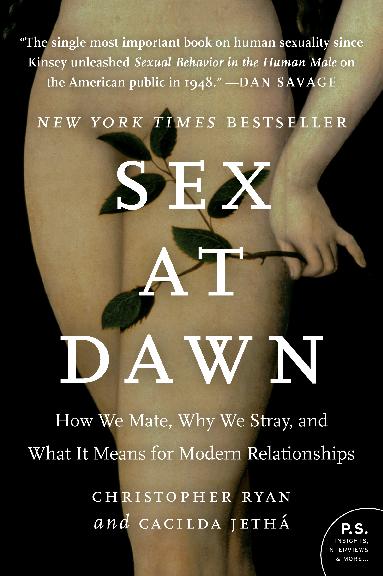
Sex at Dawn
the prehistoric origins of modern sexuality
Door: Christopher Ryan & Cacilda JethaBetoog over de natuurlijkheid van non-monogamie.
Jaar: 2010
Uitgever: Harper
ISBN: 9780061707803
Amazon.com: ‘Sex at Dawn – How We Mate, Why We Stray, and What It Means for Modern Relationships’. Since Darwin’s day, we’ve been told that sexual monogamy comes naturally to our species. Mainstream science—as well as religious and cultural institutions—has maintained that men and women evolved in families in which a man’s possessions and protection were exchanged for a woman’s fertility and fidelity. But this narrative is collapsing. Fewer and fewer couples are getting married, and divorce rates keep climbing as adultery and flagging libido drag down even seemingly solid marriages.
How can reality be reconciled with the accepted narrative? It can’t be, according to renegade thinkers Christopher Ryan and Cacilda Jethå. While debunking almost everything we “know” about sex, they offer a bold alternative explanation in this provocative and brilliant book.
Ryan and Jethå’s central contention is that human beings evolved in egalitarian groups that shared food, child care, and, often, sexual partners. Weaving together convergent, frequently overlooked evidence from anthropology, archaeology, primatology, anatomy, and psychosexuality, the authors show how far from human nature monogamy really is. Human beings everywhere and in every era have confronted the same familiar, intimate situations in surprisingly different ways. The authors expose the ancient roots of human sexuality while pointing toward a more optimistic future illuminated by our innate capacities for love, cooperation, and generosity.
With intelligence, humor, and wonder, Ryan and Jethå show how our promiscuous past haunts our struggles over monogamy, sexual orientation, and family dynamics. They explore why long-term fidelity can be so difficult for so many; why sexual passion tends to fade even as love deepens; why many middle-aged men risk everything for transient affairs with younger women; why homosexuality persists in the face of standard evolutionary logic; and what the human body reveals about the prehistoric origins of modern sexuality.
In the tradition of the best historical and scientific writing, Sex at Dawn unapologetically upends unwarranted assumptions and unfounded conclusions while offering a revolutionary understanding of why we live and love as we do.
Sex at Dawn betoogt dat de mens van nature niet monogaam is en baseert zich daarvoor op antropologische en evolutiebiologische argumenten. Zo lijken wij volgens de auteurs biologisch het meest op Bonobos, die zeer promiscue zijn. Monogamie is volgens hen cultureel bepaald en heeft pas zijn intrede gedaan toen de jager-verzamelaars zich gingen vestigen, boeren werden en voor het eerst het concept ‘bezit’ ontwikkelden. De bewijsvoering van Seks at Dawn is niet onomstreden. Lynn Saxon schreef zelfs een ‘tegenboek’, Sex at Dusk, Lifting the Shiny Wrapping from Sex at Dawn. Op haar beurt wordt de kwaliteit van Saxons werk weer bekritiseerd door tegenstanders. In deze context is het niet onbelangrijk dat alle deze discussie vooral in de USA gevoerd wordt waar vrije seksualiteit sowieso vaker leidt tot verhitte discussies dan in Europa.
Wat moet een gemiddelde polyamorist met dit boek? In de praktijk niet zo heel veel. Het is vooral een informatief en polemisch boek. Het geleerde laat zich niet zonder meer vertalen in leefregels voor ethische non-monogamie. Voor de degenen die daar behoefte aan hebben kan het boek een steun in de rug zijn: “Zie je wel, het is niet zo raar dat ik voel wat ik voel!”. Zelf voel ik die noodzaak wat minder. Een snelle blik op de statistieken over echtscheidingen en vreemdgaan is daarvoor al genoeg. Als achtergrondmateriaal is het Sex at Dawn echter zeer lezenswaardig en kan wat extra munitie geven in discussies waar nodig….


Geef een reactie